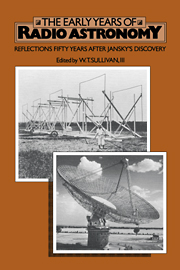Book contents
- Frontmatter
- Contents
- Preface
- THE EARLIEST YEARS
- AUSTRALIA
- ENGLAND
- The origins and early history of Jodrell Bank
- Paraboloids, galaxies and stars: memories of Jodrell Bank
- Early work on radio stars at Cambridge
- The development of aperture synthesis at Cambridge
- THE REST OF THE WORLD
- BROADER REFLECTIONS
- Biographical notes on contributors
- Name index
- Subject index
Early work on radio stars at Cambridge
Published online by Cambridge University Press: 05 March 2010
- Frontmatter
- Contents
- Preface
- THE EARLIEST YEARS
- AUSTRALIA
- ENGLAND
- The origins and early history of Jodrell Bank
- Paraboloids, galaxies and stars: memories of Jodrell Bank
- Early work on radio stars at Cambridge
- The development of aperture synthesis at Cambridge
- THE REST OF THE WORLD
- BROADER REFLECTIONS
- Biographical notes on contributors
- Name index
- Subject index
Summary
Two powerful influences acted on the early development of radio astronomy at Cambridge. The first was the existing radio research under J.A. Ratcliffe, directed primarily at the ionosphere. J.W. Findlay, who is known amongst radio astronomers as the inspiration for the 300 ft transit telescope at Green Bank and, later, as one of the designers of the Very Large Array, was a member of this research group before and after the 1939–45 war. The second influence was wartime experience in radar, when Martin Ryle in particular developed his genius for experimental methods which were at once bold, original and economical. His most important wartime work was in airborne counter-measures, involving the analysis of enemy radar and the desperate scramble to provide aircraft with warnings of radar-directed fighter attack. Ratcliffe would maintain that his own contribution was to attract Martin Ryle to the Cavendish, and to encourage him to develop his own techniques in investigating radio waves from the sun. Nevertheless Ratcliffe's influence in our understanding of radio, and even more of Fourier analysis, were other vital ingredients.
Radio research re-started in the Cavendish in 1945. Ryle, who was an Imperial Chemical Industries Research Fellow, was joined by Derek Vonberg; both were registered for Ph.D.s, although neither ever wrote a thesis. Their first approach to the measurement of solar radio waves was to build a radio version of the Michelson interferometer which would distinguish the sun from other extraneous sources of noise. They built a switched receiver known as the Cosmic Radio Pyrometer (Ryle & Vonberg 1948) in which a controllable noise diode was switched against the input noise signal.
- Type
- Chapter
- Information
- The Early Years of Radio AstronomyReflections Fifty Years after Jansky's Discovery, pp. 237 - 248Publisher: Cambridge University PressPrint publication year: 1984
- 3
- Cited by



